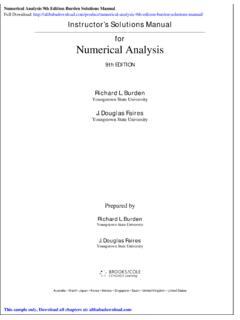Transcription of Mathematica Tutorial: Advanced Numerical Differential ...
1 Wolfram Mathematica Tutorial CollectionADVANCED Numerical Differential EQUATION SOLVING IN MATHEMATICAFor use with Wolfram Mathematica and later. For the latest updates and corrections to this manual: visit For information on additional copies of this documentation: visit the Customer Service website at or email Customer Service at Comments on this manual are welcomed at: Content authored by: Mark Sofroniou and Rob Knapp Printed in the United States of America. 15 14 13 12 11 10 9 8 7 6 5 4 3 2 2008 Wolfram Research, Inc. All rights reserved. No part of this document may be reproduced or transmitted, in any form or by any means, electronic, mechanical, photocopying, recording or otherwise, without the prior written permission of the copyright holder. Wolfram Research is the holder of the copyright to the Wolfram Mathematica software system ("Software") described in this document, including without limitation such aspects of the system as its code, structure, sequence, organization, look and feel, programming language, and compilation of command names.
2 Use of the Software unless pursuant to the terms of a license granted by Wolfram Research or as otherwise authorized by law is an infringement of the copyright. Wolfram Research, Inc. and Wolfram Media, Inc. ("Wolfram") make no representations, express, statutory, or implied, with respect to the Software (or any aspect thereof), including, without limitation, any implied warranties of merchantability, interoperability, or fitness for a particular purpose, all of which are expressly disclaimed. Wolfram does not warrant that the functions of the Software will meet your requirements or that the operation of the Software will be uninterrupted or error free. As such, Wolfram does not recommend the use of the software described in this document for applications in which errors or omissions could threaten life, injury or significant loss. Mathematica , MathLink, and MathSource are registered trademarks of Wolfram Research, Inc. J/Link, MathLM, .NET/Link, and webMathematica are trademarks of Wolfram Research, Inc.
3 Windows is a registered trademark of Microsoft Corporation in the United States and other countries. Macintosh is a registered trademark of Apple Computer, Inc. All other trademarks used herein are the property of their respective owners. Mathematica is not associated with Mathematica Policy Research, Inc. ContentsIntroduction ..1 Overview ..1 The Design of the NDSolve Framework ..11 ODE Integration Methods ..17 Methods ..17 Controller Methods ..66 Extensions ..162 Partial Differential Equations ..174 The Numerical Method of Lines ..174 Boundary Value Problems ..243 Shooting Method ..243 Chasing Method ..248 Boundary Value Problems with Parameters ..255 Differential -Algebraic Equations ..256 Introduction ..256 IDA Method ..264 Delay Differential Equations ..274 Comparison and Contrast with ODEs ..275 Propagation and Smoothing of Discontinuities ..280 Storing History Data ..284 The Method of Steps ..285 Examples ..290 Norms in NDSolve ..294 ScaledVectorNorm.
4 296 Stiffness Detection ..298 Overview ..298 Introduction ..299 Linear Stability ..301"StiffnessTest" Method Option ..304"NonstiffTest" Method Option ..305 Examples ..315 Option Summary ..323 Structured Systems ..324 Structured Systems ..324 Numerical Methods for Solving the Lotka|Volterra Equations ..324 Rigid Body Solvers ..329 Components and Data Structures ..339 Introduction ..339 Example ..340 Creating NDSolve`StateData Objects ..341 Iterating Solutions ..343 Getting Solution Functions ..344 NDSolve`StateData methods ..348 DifferentialEquations Utility Packages ..351 InterpolatingFunctionAnatomy ..351 NDSolveUtilities ..356 References ..358 Introduction to Advanced Numerical Differential Equation Solving in MathematicaOverviewThe Mathematica function NDSolve is a general Numerical Differential equation solver. It canhandle a wide range of ordinary Differential equations (ODEs) as well as some partial differentialequations (PDEs). In a system of ordinary Differential equations there can be any number ofunknown functions xi, but all of these functions must depend on a single independent variable t, which is the same for each function.
5 Partial Differential equations involve two or more indepen-dent variables. NDSolve can also solve some Differential -algebraic equations (DAEs), which aretypically a mix of Differential and algebraic a Numerical solution for the function u with t in the range tmin to Numerical solutions for several functions uiFinding Numerical solutions to ordinary Differential equations. NDSolve represents solutions for the functions xi as InterpolatingFunction objects. TheInterpolatingFunction objects provide approximations to the xi over the range of values tminto tmax for the independent variable t. In general, NDSolve finds solutions iteratively. It starts at a particular value of t, then takes asequence of steps, trying eventually to cover the whole range tmin to tmax. In order to get started, NDSolve has to be given appropriate initial or boundary conditions forthe xi and their derivatives. These conditions specify values for xi@tD, and perhaps derivativesxi @tD, at particular points t.
6 When there is only one t at which conditions are given, the equa-tions and initial conditions are collectively referred to as an initial value problem. A boundaryvalue occurs when there are multiple points t. NDSolve can solve nearly all initial value prob-lems that can symbolically be put in normal form ( are solvable for the highest derivativeorder), but only linear boundary value problems. can solve nearly all initial value prob-lems that can symbolically be put in normal form ( are solvable for the highest derivativeorder), but only linear boundary value finds a solution for x with t in the range 0 to 2, using an initial condition for x at t 1. In[1]:=NDSolve@8x @tD==x@tD, x@1D==3<, x,8t, 0, 2<DOut[1]=88x 2.<<,<>D<<When you use NDSolve, the initial or boundary conditions you give must be sufficient to deter-mine the solutions for the xi completely. When you use DSolve to find symbolic solutions todifferential equations, you may specify fewer conditions.
7 The reason is that DSolve automati-cally inserts arbitrary symbolic constants C@iD to represent degrees of freedom associated withinitial conditions that you have not specified explicitly. Since NDSolve must give a numericalsolution, it cannot represent these kinds of additional degrees of freedom. As a result, you mustexplicitly give all the initial or boundary conditions that are needed to determine the solution. In a typical case, if you have Differential equations with up to nth derivatives, then you need toeither give initial conditions for up to Hn-1 Lth derivatives, or give boundary conditions at npoints. This solves an initial value problem for a second-order equation, which requires two conditions, and are given at t== [2]:=NDSolve@8x @tD==x@tD^2, x@0D==1, x @0D==0<, x,8t, 0, 2<DOut[2]=88x 2.<<,<>D<<This plots the solution [3]:=Plot@Evaluate@x@tD .%D,8t, 0, 2<DOut[3]= Advanced Numerical Differential Equation Solving in MathematicaHere is a simple boundary value problem.
8 In[4]:=NDSolve@8y @xD+x y@xD==0, y@0D==1, y@1D==-1<, y,8x, 0, 1<DOut[4]=88y 1.<<,<>D<<You can use NDSolve to solve systems of coupled Differential equations as long as each variablehas the appropriate number of conditions. This finds a Numerical solution to a pair of coupled equations. In[5]:=sol=NDSolveB:x @tD y@tDx@tD, y @tD -1x@tD2+y@tD2,x@0D 1, x @0D 0, y@0D 0>,8x, y<,8t, 0, 100<FOut[5]=88x 100.<<,<>D, y 100.<<,<>D<<Here is a plot of both solutions. In[6]:=Plot@Evaluate@8x@tD, y@tD< .%D,8t, 0, 100<, PlotRange All, PlotPoints 200 DOut[6]=20406080100-6-4-2 You can give initial conditions as equations of any kind. If these equations have multiplesolutions, NDSolve will generate multiple solutions. The initial conditions in this case lead to multiple solutions. In[7]:=NDSolve@8y @xD^2-y@xD^3==0, y@0D^2==4<, y,8x, 1<DNDS olve::mxst:Maximum number of 10000 steps reached at the point x== `*^-8. Out[7]=98y 1.<<,<>D<,8y 1.<<,<>D<,9y InterpolatingFunctionA990.
9 , 10-8==,<>E=,8y 1.<<,<>D<=NDSolve was not able to find the solution for y @xD -Sqrt@y@xD^3D, y@0D -2 because ofproblems with the branch cut in the square root Numerical Differential Equation Solving in Mathematica 3 This shows the real part of the solutions that NDSolve was able to find. (The upper two solu-tions are strictly real.)In[8]:=Plot@Evaluate@Part@Re@y@xD .%D,81, 2, 4<DD,8x, 0, 1<DOut[8]= can solve a mixed system of Differential and algebraic equations, referred to as differen-tial-algebraic equations (DAEs). In fact, the example given is a sort of DAE, where the equa-tions are not expressed explicitly in terms of the derivatives. Typically, however, in DAEs, youare not able to solve for the derivatives at all and the problem must be solved using a differentmethod is a simple [9]:=NDSolve@8x @tD+y@tD x@tD,x@tD^2+y@tD^2 1, x@0D 0, x @0D 1<,8x, y<,8t, 0, 2<DNDS olve::ndsz:At t== `, step size is effectively zero; singularity or stiff system suspected.
10 Out[9]=88x <<,<>D, y <<,<>D<<Note that while both of the equations have derivative terms, the variable y appears without anyderivatives, so NDSolve issues a warning message. When the usual substitution to convert tofirst-order equations is made, one of the equations does indeed become effectively , since y only appears algebraically, it is not necessary to give an initial condition to deter-mine its values. Finding initial conditions that are consistent with DAEs can, in fact, be quitedifficult. The tutorial " Numerical Solution of Differential -Algebraic Equations" has Advanced Numerical Differential Equation Solving in MathematicaThis shows a plot of the [10]:=Plot@Evaluate@8x@tD, y@tD< .%D,8t, 0, <DOut[10]= the plot, you can see that the derivative of y is tending to vary arbitrarily fast. Eventhough it does not explicitly appear in the equations, this condition means that the solver can-not continue functions in Differential equations do not necessarily have to be represented by singlesymbols.







